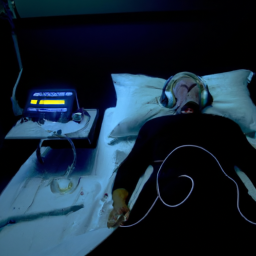Do you hear a constant ringing in your ears that seems to never go away? If so, you may be suffering from tinnitus, a condition that affects millions of people worldwide. Tinnitus can be frustrating and even debilitating, making it difficult to concentrate, sleep, or simply enjoy peace and quiet. But don’t despair, there is a natural approach to finding relief – pressure point therapy.
By targeting specific pressure points on your body, you can alleviate the symptoms of tinnitus and regain control over your life. In this article, we will explore the various pressure points that can provide relief for tinnitus, as well as a step-by-step guide on how to apply pressure point therapy. Additionally, we will discuss other natural remedies and lifestyle changes that can complement this approach.
Remember, finding relief may require consistency and patience, but with the right techniques, you can finally find peace from the ringing in your ears.
Key Takeaways
- Pressure point therapy is a natural approach to finding relief from tinnitus.
- Specific pressure points on the body, such as Tai Chong, He Gu, Feng Chi, and Zu San Li, can alleviate tinnitus symptoms.
- Consistency and patience are necessary for tinnitus relief.
- Dietary adjustments, stress reduction techniques, and relaxation exercises can also help alleviate tinnitus symptoms.
Understanding Tinnitus and Its Symptoms
Tinnitus, often described as a persistent ringing in the ears, can be a frustrating and overwhelming experience for those who suffer from it. Understanding the causes of tinnitus is crucial in finding relief.
There are several factors that can contribute to the development of tinnitus, including exposure to loud noises, age-related hearing loss, and certain medical conditions. While there’s no cure for tinnitus, there are medical treatments available that can help manage the symptoms. These treatments may include medication, sound therapy, or hearing aids.
Identifying the pressure points for tinnitus relief is another natural approach that can provide some relief. By applying gentle pressure to specific points on the body, it’s believed to alleviate the symptoms of tinnitus.
Identifying the Pressure Points for Tinnitus Relief
With a simple touch, one can unlock the hidden pathways to tranquility, like a key turning in a lock, providing a soothing symphony to the weary soul. Pressure point therapy is a natural approach to finding relief from tinnitus, and one of the most effective methods is through acupressure techniques. By applying pressure to specific points on the body, you can stimulate the flow of energy and promote relaxation.
Here are four pressure points that can help alleviate tinnitus symptoms:
-
Tai Chong (LV 3): Located on the top of the foot, between the big toe and the second toe.
-
He Gu (LI 4): Found between the thumb and index finger, on the highest spot of the muscle when the thumb and index finger are brought together.
-
Feng Chi (GB 20): Situated at the base of the skull, in the hollow between the two vertical neck muscles.
-
Zu San Li (ST 36): Positioned below the kneecap, on the outer side of the leg.
By incorporating these acupressure techniques into your routine, you can discover a natural path to tinnitus relief. Transitioning to the subsequent section about the step-by-step guide to applying pressure point therapy, you can learn how to effectively target these pressure points for maximum results.
Step-by-Step Guide to Applying Pressure Point Therapy
Embark on a journey to tranquility as you explore the step-by-step guide to applying the therapeutic technique of pressure point therapy for tinnitus relief. Pressure point techniques have been used for centuries to alleviate various ailments, and when it comes to tinnitus, acupressure points can be particularly effective.
Begin by locating the pressure points on your body that are associated with tinnitus relief, such as the Shen Men point located on the outer ear. Apply gentle pressure using your thumb or index finger and hold for a few minutes. You can also try massaging the points in a circular motion to enhance the effects.
Repeat this process daily to experience the full benefits of pressure point therapy. By incorporating these techniques into your daily routine, you can find relief from tinnitus in a natural and non-invasive way.
Transitioning into the subsequent section, let’s explore other natural remedies and lifestyle changes for tinnitus relief.
Other Natural Remedies and Lifestyle Changes for Tinnitus Relief
To further address tinnitus relief through natural remedies and lifestyle changes, there are two key points to consider: dietary adjustments and stress reduction techniques.
Making certain changes to your diet, such as reducing salt and caffeine intake, can potentially help alleviate tinnitus symptoms.
Additionally, incorporating stress reduction techniques, such as exercise and mindfulness practices, may also provide relief.
Dietary Adjustments
Making tweaks to your diet is like adding the perfect seasoning to your tinnitus relief journey. Dietary modifications can play a significant role in managing tinnitus symptoms and improving overall well-being.
Certain nutrients have been found to have a positive impact on the auditory system and can help reduce inflammation, which is often associated with tinnitus. For example, incorporating foods rich in antioxidants, such as fruits and vegetables, can help protect against oxidative stress and potentially alleviate tinnitus. Additionally, increasing your intake of omega-3 fatty acids, found in fish and nuts, may have anti-inflammatory effects and provide relief.
It’s important to consult with a healthcare professional or nutritionist to ensure you’re getting a balanced diet and adequate nutrition. By making these dietary adjustments, you can take a proactive approach to managing your tinnitus and improving your overall health.
Transitioning into stress reduction techniques, let’s explore additional strategies to find relief.
Stress Reduction Techniques
Take a moment to breathe deeply and let go of the tension in your body, because finding effective stress reduction techniques can bring much-needed calm and peace to your tinnitus journey.
Here are three relaxation exercises and meditation techniques that can help alleviate stress and potentially reduce the symptoms of tinnitus:
-
Progressive Muscle Relaxation: This technique involves tensing and then releasing each muscle group in your body, promoting relaxation and reducing muscle tension.
-
Deep Breathing: By focusing on slow, deep breaths, you can activate your body’s relaxation response and decrease stress.
-
Mindfulness Meditation: This practice encourages you to be fully present in the moment, letting go of worries and calming your mind.
Incorporating these techniques into your daily routine can help manage stress levels and potentially provide relief from tinnitus symptoms. Consistency and patience are key in finding relief and improving your overall well-being.
The Importance of Consistency and Patience in Finding Relief
Picture yourself on a calm beach, waves gently lapping against the shore, as you embrace the importance of consistency and patience in your journey to find relief from tinnitus. Consistency is key when it comes to any treatment or approach for tinnitus. It takes time for your body to adjust and respond to any changes you make. Patience is equally important, as it can be easy to get discouraged if you don’t see immediate results. Remember, finding relief from tinnitus is a process that requires dedication and perseverance.
To help you understand the significance of consistency and patience, let’s take a look at the following table:
| Consistency | Patience | Results |
|---|---|---|
| Daily | Steady | Gradual |
| Routine | Endurance | Sustainable |
| Persistent | Resilience | Long-lasting |
This table highlights the correlation between consistency, patience, and the desired results. By consistently implementing a routine and persistently practicing stress reduction techniques, you can achieve sustainable and long-lasting relief from tinnitus. So, remain committed, stay patient, and trust the process. Relief is within reach.
Frequently Asked Questions
Can pressure point therapy completely cure tinnitus?
Pressure point therapy may provide some relief for tinnitus, but it’s unlikely to completely cure the condition. While it can help manage symptoms, it has potential limitations. The efficacy of pressure point therapy in comparison to other tinnitus treatments is still unclear. It’s important to note that individual experiences may vary, and what works for one person may not work for another. Consulting with a healthcare professional is recommended for a comprehensive approach to tinnitus relief.
Are there any potential side effects of pressure point therapy for tinnitus relief?
When considering pressure point therapy for tinnitus relief, it’s important to be aware of potential risks and precautions. Although generally safe, some people may experience temporary discomfort or bruising at the pressure points. It’s crucial to apply appropriate pressure and technique to avoid any adverse effects.
The effectiveness of pressure point therapy varies among individuals, and the duration of therapy may also differ. Consulting a healthcare professional for guidance on the appropriate pressure points and duration is recommended.
Can pressure point therapy be used as a standalone treatment for tinnitus, or does it need to be combined with other remedies?
Pressure point therapy can be used as a standalone treatment for tinnitus, but it may be more effective when combined with other remedies. While pressure point therapy targets specific points on the body to alleviate symptoms, it’s important to address the underlying causes of tinnitus as well. This may involve incorporating lifestyle changes, such as reducing stress and avoiding loud noises, along with other treatments like sound therapy or medication. Combining different approaches can provide a more comprehensive and holistic approach to tinnitus relief.
How long does it usually take to see results from pressure point therapy for tinnitus relief?
Results from pressure point therapy for tinnitus relief can vary depending on the individual. Some people may experience improvements in their symptoms within a few weeks, while others may take longer. It is important to note that pressure point therapy isn’t a guaranteed cure for tinnitus and may not work for everyone. As for potential side effects, they’re generally minimal and may include temporary soreness or discomfort at the pressure points.
Are there any specific pressure points that should be avoided or approached with caution when using pressure point therapy for tinnitus relief?
When using pressure point therapy for tinnitus relief, it’s important to be cautious and avoid certain pressure points. The temples, for example, should be approached with caution as they’re sensitive areas.
Additionally, the area at the base of the skull, known as the occipital region, should be avoided as it can cause discomfort.
While pressure point therapy can provide benefits for tinnitus relief, it’s crucial to be aware of these potential limitations and exercise caution when applying pressure to specific points.
Conclusion
In conclusion, finding relief for tinnitus can be a challenging journey, but with consistency and patience, you can make progress. By identifying pressure points and applying pressure point therapy, you can potentially alleviate the symptoms of tinnitus naturally.
Additionally, incorporating other natural remedies and making lifestyle changes can further enhance your chances of finding relief. Remember the adage, "Rome wasn’t built in a day." Be persistent in your efforts and trust that over time, you can find the relief you seek.
Stay committed and don’t give up, as relief is possible.




